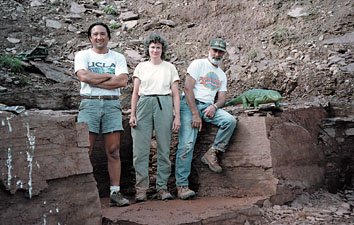

Until very recently the history of Early Permian land-dwelling vertebrates has been almost entirely documented by fossils found in the United States. However, since 1993 David Berman, along with colleagues Dr. Stuart S. Sumida from California State University at San Bernardino and Dr. Thomas Martens from the Museum der Natur in Gotha, Germany, have been unearthing the first superbly preserved examples of strictly land-dwelling, Early Permian animals in Germany. These animals are identical to those found by Berman across the United States. This similarity is the first undeniable biological evidence that North America and Europe were once joined in a continuous landmass. The site of this remarkable discovery is the Bromacker quarry in the Thuringian Forest south of Gotha, in eastcentral Germany.
One recently unearthed example of a global-wide inhabitant from the
Bromacker quarry is a bizarre, plant-eating animal called Diadectes. Nick-named
the “Permian cow” because of its large size (reaching ten feet in length)
and barrel-shaped trunk, Diadectes is the oldest known animal restricted
to a diet of land plants. Its wanderings have been documented from the
southwestern United States to West Virginia, and now across the Atlantic
Ocean in Germany.
A pair of complete skeletons of the amphibian Seymouria from the Bromacker
quarry offers even more proof of continental drift. Known previously only
from southwestern United States, the museum’s Benedum Hall of Geology displays
a block of rock with five excellent skeletons that were collected by Berman
in New Mexico in the early 1980s. The Bromacker specimens were shipped
back to Pittsburgh for the museum’s preparator Amy Henrici to “prepare,”
since Carnegie Museum of Natural History is known worldwide for its excellence
in removing fossils from the hard surrounding matrix of rock.
As might be expected the Bromacker quarry has yielded some uniquely
different animals. Easily the most fascinating new-to-science animal recovered
so far is a 10-inch long reptile. Many features of its skeleton, such as
its extraordinarily long tail and long hindlimbs, and its relatively short
forelimbs, indicate that it was probably capable of dashing about in a
semi-erect posture on its hindlimbs, perhaps to chase down slower insects
for food or sprint away from predators and avoid being eaten. If true,
this creature predates the next oldest known animals capable of two-legged
locomotion (including dinosaurs) by perhaps 70 million years.
This paleontological research has been supported by The National Geographic
Society, the Graham Netting and Edward O’Neil research funds of the Carnegie
Museum of Natural History, NATO, and the Museum der Natur Gotha in Germany.
—R. Jay Gangewere
Contents |
Highlights |
Calendar |
Back Issues |
Museums |